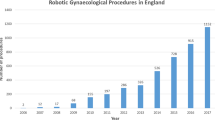Abstract
This study evaluated intraoperative complications and postoperative outcomes of gynecologic oncology patients undergoing robotic-assisted (RA) laparoscopic procedures in a university setting. A retrospective chart review evaluated all gynecologic oncology patients at the University of Alabama at Birmingham who underwent attempted RA procedures between August 2006 and October 2011. Patient demographics, medical/surgical history, intraoperative complications, postoperative outcomes, conversion rates, readmission rates, and length of stay were examined. Total complication rates were assessed over time for each surgeon. 681 patients underwent planned RA procedures by seven gynecologic oncologists. The mean body mass index was 33.5 kg/m2 (range 16.6–71.0 kg/m2). 61.4 % were diagnosed with malignancy. The most common procedure was RA hysterectomy with unilateral/bilateral salpingo-oophorectomy (37.2 %). Robotic staging was performed in 291 patients (45.1 %). Mean estimated blood loss was 75 ml (range 5–700 ml). 36 patients (5.3 %) were converted to laparotomy. The most common reason for conversion was adhesions (30.1 %), followed by uterine size (22.2 %). In 107 cases, a surgical modification was required for specimen removal including mini-laparotomy (24), extension of accessory port (36), morcellation (9), and difficult vaginal delivery (38). 3.7 % had intraoperative complications; 6 patients had a cystotomy and 5 had a vascular injury. Postoperatively, 20 patients had a febrile episode, 9 had wound complications, and 3 had a vaginal cuff dehiscence. 27 (4.2 %) patients were readmitted within 30 days. Complication rates and conversion rates were similar per surgeon. Total complication rates for evaluable surgeons were similar between the first 10 cases and subsequent 50 cases. Although patients undergoing RA procedures in a university setting are high risk, the conversion rate to laparotomy is low and intraoperative and postoperative complications are acceptable. Total complication rates for each surgeon were not impacted by the number of cases performed.
Similar content being viewed by others
References
Walker JL, Piedmonte MR, Spirtos NM, Eisenkop SM, Schlaerth JB, Mannel RS, Spiegel G, Barakat R, Pearl ML, Sharma SK (2009) Laparoscopy compared with laparotomy for comprehensive surgical staging of uterine cancer: Gynecologic Oncology Group Study LAP2. J Clin Oncol 27(32):5331–5533
Walker JL, Piedmonte MR, Spirtos NM, Eisenkop SM, Schlaerth JB, Mannel RS, Barakat R, Pearl ML, Sharma SK (2012) Recurrence and survival after random assignment to laparoscopy versus laparotomy for comprehensive surgical staging of uterine cancer: Gynecologic Oncology Group LAP2 Study. J Clin Oncol 30(7):695–700
Subramaniam A, Kim KH, Bryant SA, Zhang B, Sikes C, Kimball KJ, Kilgore LC, Huh WK, Straughn JM Jr, Alvarez RD (2011) A cohort study evaluating robotic versus laparotomy surgical outcomes of obese women with endometrial carcinoma. Gynecol Oncol 122(3):604–607
Gallo T, Kashani S, Patel DA, Elsahwi K, Silasi DA, Azodi M (2012) Robotic-assisted laparoscopic hysterectomy: outcomes in obese and morbidly obese patients. JSLS 16(3):421–427
Tang KY, Gardiner SK, Gould C, Osmundsen B, Collins M, Winter WE 3rd (2012) Robotic surgical staging for obese patients with endometrial cancer. Am J Obstet Gynecol 206(6):513 e511–516 e511
Bernardini MQ, Gien LT, Tipping H, Murphy J, Rosen BP (2012) Surgical outcome of robotic surgery in morbidly obese patient with endometrial cancer compared to laparotomy. Int J Gynecol Cancer 22(1):76–81
Gehrig PA, Cantrell LA, Shafer A, Abaid LN, Mendivil A, Boggess JF (2008) What is the optimal minimally invasive surgical procedure for endometrial cancer staging in the morbidly obese woman? Gynecol Oncol 111(1):41–45
Sfakianos GP, Frederick PJ, Kendrick JE, Straughn JM, Kilgore LC, Huh WK (2010) Robotic surgery in gynecologic oncology fellowship programs in the USA: a survey of fellows and fellowship directors. Int J Med Robot 6(4):405–412
Wright JD, Burke WM, Wilde ET, Lewin SN, Charles AS, Kim JH, Goldman N, Neugut AI, Herzog TJ, Hershman DL (2012) Comparative effectiveness of robotic versus laparoscopic hysterectomy for endometrial cancer. J Clin Oncol 30(8):783–791
Woelk JL, Casiano ER, Weaver AL, Gostout BS, Trabuco EC, Gebhart JB (2013) The learning curve of robotic hysterectomy. Obstet Gynecol 121(1):87–95
Schreuder HW, Zweemer RP, van Baal WM, van de Lande J, Dijkstra JC, Verheijen RH (2010) From open radical hysterectomy to robot-assisted laparoscopic radical hysterectomy for early stage cervical cancer: aspects of a single institution learning curve. Gynecol Surg 7(3):253–258
Gaia G, Holloway R, Santoro L, Ahmad S, Di Silverio E, Spinillo A (2010) Robotic-assisted hysterectomy for endometrial cancer compared with traditional laparoscopic and laparotomy approaches: a systematic review. Obstet Gynecol 116(6):1422–1431
Kashani S, Gallo T, Sargent A, Elsahwi K, Silasi DA, Azodi M (2012) Vaginal cuff dehiscence in robotic-assisted total hysterectomy. JSLS 16(4):530–536
Conflict of interest
Dr. Walters Haygood has no stated financial conflicts of interest. Dr. Fauci has no stated financial conflicts of interest. Dr. Huddleston-Colburn has no stated financial conflicts of interest. Dr. Huh has no stated financial conflicts of interest. Dr. Straughn has no stated financial conflicts of interest.
Author information
Authors and Affiliations
Corresponding author
Rights and permissions
About this article
Cite this article
Walters Haygood, C.L., Fauci, J.M., Huddleston-Colburn, M.K. et al. Outcomes of gynecologic oncology patients undergoing robotic-assisted laparoscopic procedures in a university setting. J Robotic Surg 8, 207–211 (2014). https://doi.org/10.1007/s11701-014-0452-5
Received:
Accepted:
Published:
Issue Date:
DOI: https://doi.org/10.1007/s11701-014-0452-5




